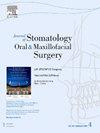外切口在矫正东亚患者因皮肤厚度造成的球根状鼻尖中的应用。
IF 2
3区 医学
Q2 DENTISTRY, ORAL SURGERY & MEDICINE
Journal of Stomatology Oral and Maxillofacial Surgery
Pub Date : 2025-10-01
DOI:10.1016/j.jormas.2025.102327
引用次数: 0
摘要
背景:东亚患者的球根状鼻尖通常是由皮肤厚和软组织肥大引起的,这给鼻整形术带来了挑战。本研究评估鼻尖上切除联合软骨重塑治疗鼻尖肥大和减少疤痕的有效性和安全性。方法:回顾性分析2021年1月至2023年10月接受球茎状鼻尖矫正的患者。手术入路包括中线椭圆尖上切除、软骨移植(来自中隔、肋骨或耳朵)和外侧脚调整。通过人体测量(鼻长、鼻尖突出(NTP)、鼻唇角(NLA))、鼻整形结果评估(ROE)评分和患者与观察者疤痕评估量表(POSAS)评估结果。结果:13例东亚患者(平均年龄29.23岁)符合纳入标准。术后结果显示鼻长减少20% (7.29 cm至5.83 cm, p < 0.001), NTP增加8.3% (18.98 mm至20.56 mm, p < 0.001), NLA改善7.2°(82.59°至88.64°,p < 0.001)。ROE评分显著提高(p < 0.001)。疤痕满意率为96.16%,15.38%的病例有最小的不规则性。结论:鼻尖上部切除能有效矫正东亚患者的球根状鼻尖,改善鼻部轮廓,提高患者满意度。谨慎的患者选择和疤痕管理是确保手术成功的关键。需要更大规模的进一步研究来确认长期结果。本文章由计算机程序翻译,如有差异,请以英文原文为准。
The application of external incision in correcting bulbous nasal tip caused by skin thickness in East Asian patients
Background
Bulbous nasal tips in East Asian patients are often caused by thick skin and soft tissue hypertrophy, presenting challenges in rhinoplasty. This study evaluates the efficacy and safety of supratip excision combined with cartilage reshaping to address nasal tip hypertrophy and minimize scarring.
Methods
A retrospective analysis was performed on patients who underwent bulbous nasal tip correction from January 2021 to October 2023. The surgical approach involved midline elliptical supratip excision, cartilage grafting (from septum, rib, or ear), and lateral crural adjustments. Outcomes were assessed using anthropometric measurements (nasal length, tip projection [NTP], nasolabial angle [NLA]), the Rhinoplasty Outcome Evaluation (ROE) score, and the Patient and Observer Scar Assessment Scale (POSAS).
Results
Thirteen East Asian patients (mean age: 29.23 years) met the inclusion criteria. Postoperative results showed a 20 % reduction in nasal length (7.29 cm to 5.83 cm, p < 0.001), 8.3 % increase in NTP (18.98 mm to 20.56 mm, p < 0.001), and 7.2° improvement in NLA (82.59° to 88.64°, p < 0.001). ROE scores improved significantly (p < 0.001). Scar satisfaction was 96.16 %, with minimal irregularities noted in 15.38 % of cases.
Conclusion
Supratip excision effectively corrects bulbous nasal tips in East Asian patients, resulting in refined nasal contours and high patient satisfaction. Careful patient selection and scar management are paramount to ensure the success of the procedure. Further studies with larger cohorts are needed to confirm long-term outcomes.
求助全文
通过发布文献求助,成功后即可免费获取论文全文。
去求助
来源期刊

Journal of Stomatology Oral and Maxillofacial Surgery
Surgery, Dentistry, Oral Surgery and Medicine, Otorhinolaryngology and Facial Plastic Surgery
CiteScore
2.30
自引率
9.10%
发文量
0
审稿时长
23 days
 求助内容:
求助内容: 应助结果提醒方式:
应助结果提醒方式:


